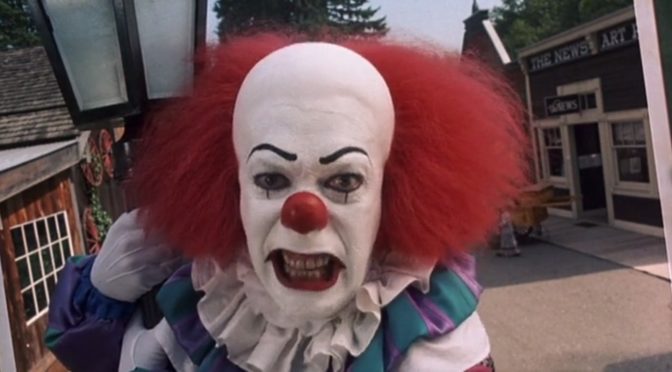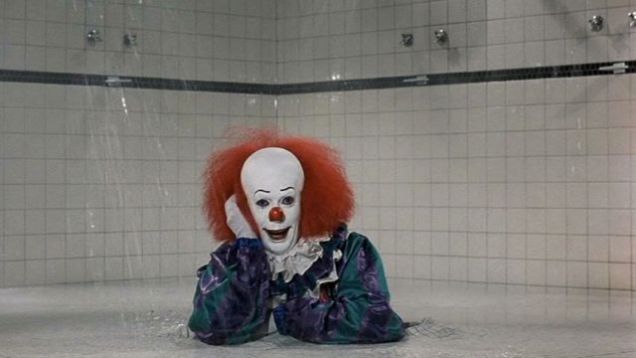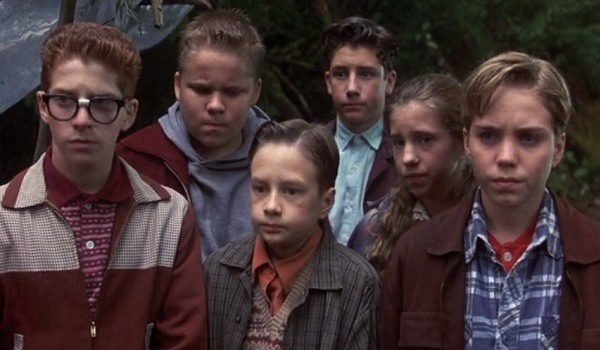“To the Losers Club.”
There’s a problem in America right now: creepy clowns. They’re fucking everywhere, guys, and that would be scary enough as it is, but I think there’s a reason we find it so scary. That reason is It. Stephen King’s 1986 novel is, in my opinion, his masterpiece (or at least tied with The Stand), and it is almost singlehandedly responsible for a rash of coulrophobia that has never really left our collective consciousness. Tommy Lee Wallace’s 1990 miniseries is, in a lot ways, an adaptation that leaves too much of its source material untapped, but that’s understandable when you have three hours to adapt an 1,100-page book.
But there’s a reason that It endures, and that reason is Tim Curry. His performance as Pennywise the Clown is what people think of when they think of a creepy clown, but Pennywise is so much more than that. Curry has to embody something cosmic and metaphysical – “I am eternal,” he croaks at one point, “the eater of worlds, and of children!” – and he does so brilliantly. The next actor to play Pennywise will be Hemlock Grove‘s Bill Skargard, and he has some impossibly big shoes to fill. Curry’s Pennywise is the kind of villain who you miss when he’s not on screen, and one of the scariest things about him is that sometimes he’s actually funny.
Wallace does a good job juggling a frankly overstuffed cast, which, again, makes sense in a novel as long as It. This could have been the film’s undoing (okay, it’s a miniseries, but my Blu-Ray copy played it as one three-hour movie), but the cast acquits themselves nicely, especially the younger actors. Bill Denbrough (Jonathan Brandis as a kid, Richard Thomas as an adult) is one of King’s most likable, relatable heroes, but It doesn’t overlook Ben (Brandon Crane, John Ritter), Bev (Emily Perkins, Annette O’Toole), Richie (Seth Green, Harry Anderson), Eddie (Adam Faraizl, Dennis Christopher), Stan (Ben Heller, Richard Masur), or Mike (Marlon Taylor, Tim Reid). In an extremely rare occurrence, the children are more compelling than the adults (we in the biz call this the Stranger Things Corollary), which can unbalance the film; the first half zips along with more urgency than does the second. Together, the Losers Club, as they call themselves, have to rid their town of Derry, Maine of It, an unnamed and incomprehensible evil that arises every thirty years to feed itself. (In a lot of ways, It is a tribute to Lovecraft’s monsters, given a very Kingian twist.)
Since It is fear made incarnate, the film is able to cleverly utilize a lot of surreal imagery that manages to be both weird and horrifying. I’m thinking of the locker-room shower nozzles extending from the wall like metal snakes, spraying Eddie with scalding water, or of a kindly woman turning into an old crone and speaking to Bev in the voice of her abusive father, or of hundreds of balloons pouring out of a refrigerator. Some of the images should seem hokey, but It uses incongruity to its benefit. There’s no reason a werewolf in a letterman jacket, or a mummy descending the stairs of a well-appointed manor in the middle of a park, should be scary. But clowns were never supposed to be scary either. (The only scare that really doesn’t hold up is the sight of a dog’s head on Pennywise’s body.)
It comes down to two basic themes: friendship and belief. The Losers Club wouldn’t have been able to defeat It in 1958 if they didn’t believe they could, and there’s something of a triumphant moment when Eddie marches up to Pennywise, brandishing his inhaler, and proclaims “This is battery acid, you slime!” Years later, the adult Eddie will sacrifice himself for the group in much the same way.
Friendship is text here, not subtext, and King (who remains the best popular author when it comes to writing about childhood) slyly acknowledges the youthful power of belief by showing the kids determined to take on Pennywise, while the adults doubt their ability to do so (“I still think we should have brought a machine gun,” Richie quips). The power of their friendship is such that It genuinely fears them, otherwise why would he spend so much time taunting and trying to intimidate them when they return to Derry? (Even he thinks less of the adult version of the Losers Club, snarling at Richie, “You’re too old to stop me!”)
In a story like this, the climax is almost bound to feel unsatisfactory, and that’s unfortunately true. The big spider looks dated now, and they basically just kick its ass until it dies. But the real climax comes after the Losers Club leaves the sewer, and Bill takes his comatose wife Audra (Olivia Hussey) for a ride on his old bike. “This saved Stan’s life once,” he tells her. “Maybe it will save yours.” And it does. Once again, this should seem hokey, but it’s actually quite stirring. What It tells us is that your fears are only as powerful as you believe them to be.
There have been better King adaptations, but It makes a good case for top-ten placement. It takes the time to be moving and joyous, while also managing to be unsettling, gruesome, and terrifying. And the use of Pennywise literally changed what we thought was scary. Even if the special effects look a little old-fashioned now, It still has Tim Curry, and his performance is the best practical effect in the film.
10/1: Dawn of the Dead (2004)
10/2: The Exorcist
10/3: Pontypool
10/4: Hocus Pocus
10/5: The Orphanage
10/6: Rosemary’s Baby
10/7: Alien
10/8: Scream series
10/9: Scream series
10/10: Cujo
10/11: The Cabin in the Woods
10/12: Pulse
10/13: The Babadook
10/14: Friday the 13th
10/15: The Last House on the Left (both versions)
10/16: The Thing (both versions)
10/17: Little Shop of Horrors
10/18: Hush
10/19: Silent Hill
10/20: The Shining
10/21: Funny Games (2007)
10/22: Evil Dead series
10/23: Evil Dead series
10/24: The Mist
10/25: The Ninth Gate
10/26: The Fly
10/27: A Nightmare on Elm Street
10/28: The Nightmare Before Christmas
10/29: 28 Days Later/28 Weeks Later
10/30: It
10/31: Halloween (either version)



